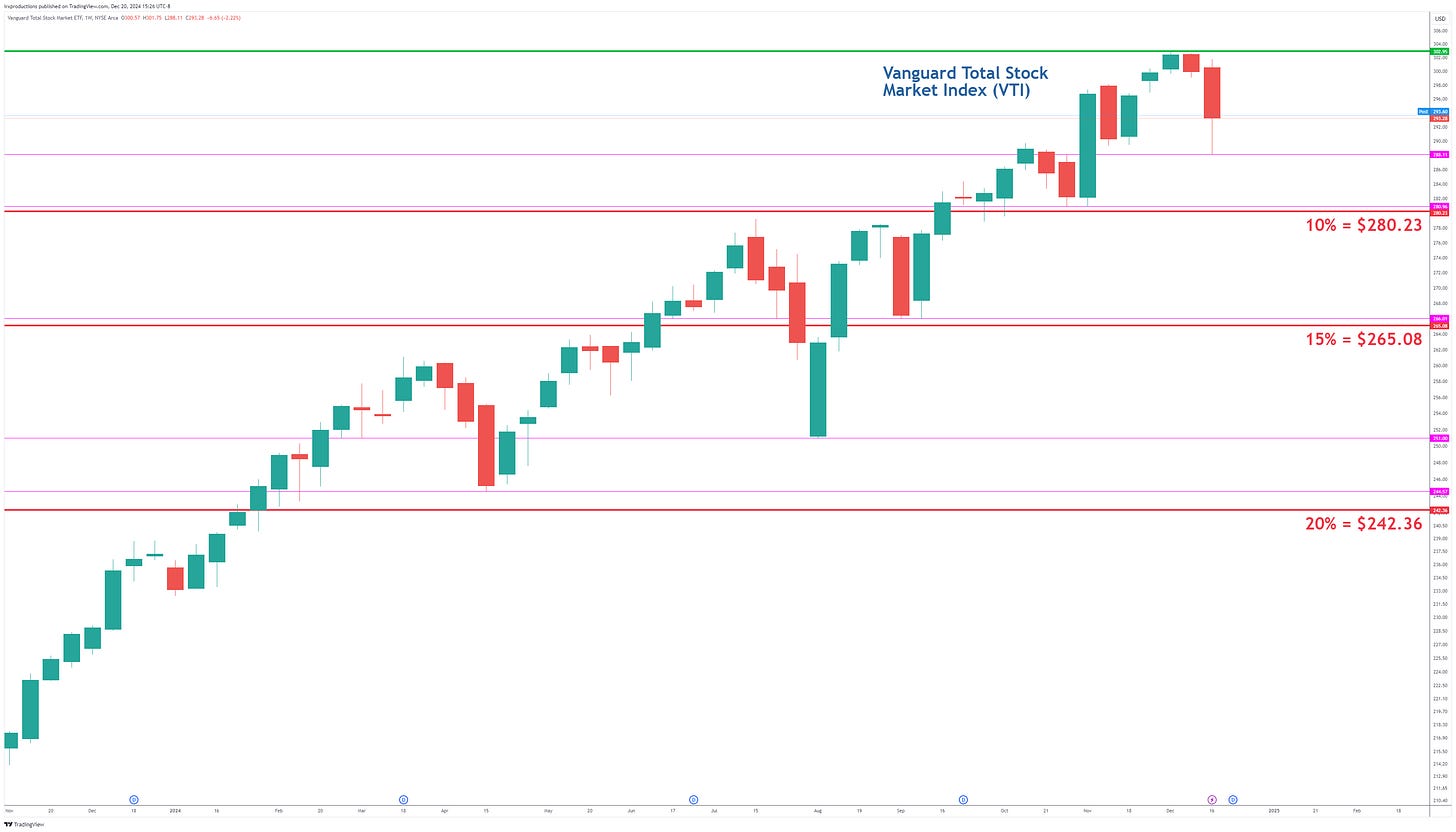Buying the CRASH! My ETF & Stock Shopping List for 12/23-27, 2024
Buying and selling price targets for Irk's 60+ positions! | Issue #33
Introducing the ETF Outlook for Next Week
One of my readers asked if I would be willing to provide my broader thoughts on the market each week, in addition to my individual position buy and sell targets. I think this is a great idea! (Thank you, Sergio!)
Going forward, I will provide a broader view as to where I might add to or reduce exposure to ETFs using a broad-based ETF I own in some of my non-public accounts: the Vanguard Total Stock Market Index (VTI). Unlike S&P 500 ETFs like SPY or VOO (Vanguard's own S&P 500 ETF), VTI attempts to track the performance of the entire stock market, not just the 500 largest companies.
Additionally, VTI's 0.03% expense ratio (annual fee) is lower than SPY's and in-line with VOO's, which are 0.09% and 0.03%, respectively. For those interested in avoiding fees entirely, Fidelity offers a similar product in the form of FZROX, the appropriately named Fidelity ZERO Total Market Index, which carries an expense ratio of zero!
Vanguard Total Stock Market Index (VTI) ETF Outlook
Throughout the course of healthy bull markets, it's quite normal to see pullbacks and corrections. A pullback is usually less than 5%, while a correction can be anywhere from 5% to 15%.
While the technical definition of a "Bear Market" is a pullback in the S&P 500 (SPX) of 20% or more, you begin to split hairs when looking at crashes like December 2018, where the S&P 500 pulled back 19.95% from peak to trough. Could that be considered a Bear Market? Absolutely, in my opinion.
So, as we review the price action of VTI over the last week, we're decidedly pulling back, but where could we find support?
You will notice in VTI's Weekly-Timeframe Chart above that, in addition to key pullback levels that I've marked in red, I've also identified other potential areas of support in magenta. These are areas where VTI has found support in the past.
Since I'm a more aggressive investor, I want to ensure that I continue to put money to work, so rather than wait for VTI to pull back to precisely 10%, 15%, or 20%, I prefer to use the higher levels of support as price targets instead, just in case VTI finds support at those higher levels and never fully attains a round number pullback.
It's important to remember that support is not 100% definitive. It's better to think of potential support like falling into bed: the mattress doesn't stop your body immediately; you sink into it.
Accordingly, more conservative investors might target the round-number support (or lower) as it's always possible VTI could sell off slightly lower than 10%, 15%, or 20% and then find support.
For me, I’ll be buying at the following price targets:
$279.86 (this is a bit below the next potential level of support but that’s simply because I already added this week during the pullback)
$268.30 (above the next level of key support)
$253.06 (above the low from August 5th)
$242.40 (slightly above a -20% pullback)
Naturally, these aren't all of my price targets, just my next four buys. Just like my publicly-traded stock accounts, I always keep dry powder available to add in stages if we see more epic drawdowns.
What if you didn’t add last week?
It's worth noting that had I not added to my position last week, my next buy target would be above $288.11, the low for the week. While it's not guaranteed that VTI will retest that low or, if it does, that the low will hold, the fact that buyers stepped in and called that the bottom (for now) is an indication that it could potentially find support there again during the next big pullback.
By planning out all of my buy targets in advance, I remove EMOTION from buys. Instead of looking at pullbacks and worrying that the market may pull back much further than my next buy, I realize that I performed all my planning in advance when I could be objective and unemotional. Yes, the market may pull back further than my next point, and that's fine; I'll just buy more.
What’s my Exit Strategy?
Sergio asked about my exit or sell targets. Well, I don't trim my ETF accounts like I do my publicly-traded stock accounts.
Whereas my Speculation in Play, Pandemic Portfolio, and Investments in Play are closed-end accounts (i.e., I never add new funds to any of these accounts to maintain the integrity of the process), my ETF accounts regularly see significant inflows of cash. Accordingly, I need to put that cash to work.
Instead, I choose to diversify by diversifying investing strategies as well as investments.
In fact, I have different strategies for all six (yes, 6!) of my personal portfolios:
Speculation in Play, Pandemic Portfolio, and Investments in Play all manage individual positions by adding and selling in stages.
My Retirement ETF Account adds in stages but never trims unless I’ve adjusted the allocation strategy for the held positions.
My End-of-the-World ETF Account which remains mainly in cash in the event that we have a Black Swan Event like the COVID-19 pandemic where it will put significant cash to work at much lower levels. Like my publicly-traded portfolios, this account also adds and sells in stages.
My Dumb Money Account doesn’t add in stages. Instead, it Dollar-Cost Averages (DCA) by adding to five different ETFs every Friday, regardless of the price action. It also never sells unless I adjust the allocation sizes for the ETFs which I have no intention of doing so. I call this my “Dumb Money Account” because it does what financial “professionals” tell us to do: it buys and holds.
My Individual Stock Buy & Sell Targets
Premium Members: Read on to find my shopping list for each of my 60+ individual stock positions across my three publicly-traded portfolios: Speculation in Play, the Pandemic Portfolio, and, my flagship portfolio: Investments in Play.
Keep reading with a 7-day free trial
Subscribe to Get Irked - Teaching Long-Term Investing Success to keep reading this post and get 7 days of free access to the full post archives.






